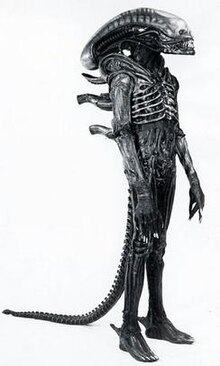
Back Xenomorfu AST Xenomorf Catalan Vetřelec Czech Alien (estaĵo) Esperanto Xenomorfo Spanish Ksenomorfid Estonian Alien (rotu) Finnish Alien (créature) French זינומורף HE Az Alien-univerzum lényei Hungarian
| Xenomorph | |
|---|---|
| Alien and Alien vs. Predator race | |
 Xenomorph in Alien (1979) | |
| First appearance | Alien (1979) |
| Created by | |
| In-universe information | |
| Other name(s) |
|
| Home world | Xenomorph Prime |
| Type | Endoparasitoid lifeform |
The xenomorph (also known as a Xenomorph XX121 or Internecivus raptus, and simply the alien or the creature[a])[1][2][3][4] is a fictional endoparasitoid extraterrestrial species that serves as the title antagonist of the Alien and Alien vs. Predator franchises. The species made its debut in the film Alien (1979) and reappeared in the sequels Aliens (1986), Alien 3 (1992), Alien Resurrection (1997), and Alien: Romulus (2024). The species returns in the prequel series, first with a predecessor in Prometheus (2012) and a further evolved form in Alien: Covenant (2017),[5] and the 2019 short films Alien: Containment, Specimen, Night Shift, Ore, Harvest, and Alone. It also featured in the crossover films Alien vs. Predator (2004) and Aliens vs. Predator: Requiem (2007), with the skull and tail of one of the creatures respectively appearing briefly in Predator 2 (1990), Predator: Concrete Jungle (2005), Predators (2010), and The Predator (2018), as a protagonist (named 6) in the video game Aliens vs. Predator (2010), and will return in the upcoming FX television series Alien: Earth (2025). In addition, the xenomorph appears in various literature and video game spin-offs from the franchises.
The xenomorph's design is credited to Swiss surrealist and artist H. R. Giger, originating in a lithograph titled Necronom IV and refined for the series's first film, Alien. The practical effects for the xenomorph's head were designed and constructed by Italian special effects designer Carlo Rambaldi. Species design and life cycle have been extensively augmented, sometimes inconsistently, throughout each film.
Unlike many other extraterrestrial races in film and television science fiction (such as the Daleks and Cybermen in Doctor Who, or the Klingons and Borg in Star Trek), the xenomorphs are not sapient toolmakers — they lack a technological civilization of any kind, and are instead primal, predatory creatures with no higher goal than the preservation and propagation of their own species by any means necessary, up to and including the elimination of other lifeforms that may pose a threat to their existence. Like wasps or termites, xenomorphs are eusocial, with a single fertile queen breeding a caste of warriors, workers, or other specialist strains. The xenomorphs' biological life cycle involves traumatic implantation of endoparasitoid larvae inside living hosts; these "chestburster" larvae erupt from the host's body after a short incubation period, mature into adulthood within hours, and seek out more hosts for implantation.
Cite error: There are <ref group=lower-alpha> tags or {{efn}} templates on this page, but the references will not show without a {{reflist|group=lower-alpha}} template or {{notelist}} template (see the help page).
- ^ Alien: The Weyland-Yutani Report
- ^ Alien: Sea of Sorrows
- ^ Dan O'Bannon and Ronald Shusett (writers) and James Cameron (director) (1986). Aliens (DVD). 20th Century Fox.
- ^ Vincent Ward (writer) and David Fincher (director) (1992). Alien 3 (DVD). 20th Century Fox.
- ^ Gaska, Andrew E. C. (2019). Alien: The Roleplaying Game. Free League Publishing. p. 284.
© MMXXIII Rich X Search. We shall prevail. All rights reserved. Rich X Search